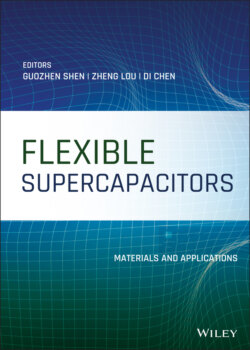Читать книгу Flexible Supercapacitors - Группа авторов - Страница 31
2.2.1.3 Fabrication of Stretchable Coaxial SCs
ОглавлениеAmong the three structures of fiber SCs, the fabrication of stretchable coaxial SCs is the most complicated, but this configuration makes the device more integrated than the parallel and twisted structures [59]. The biggest difficulty lies in the fabrication of sheath/shell‐like electrode (outer electrode). To date, many efforts have been devoted to the development of novel coaxial SCs. For example, Lee et.al proposed an assembly method by wrapping separator and carbon nanofiber (CNF) film on the surface of the core fiber electrode, but it makes the contact resistance large and the electrode materials waste [44]. In contrast to this structure, Peng's group reported a stretchable coaxial SCs that fabricate layer by layer, from inside to outside, in sequence of inner electrode, gel electrolyte and outer electrolyte without separator, as shown in Figure 2.5a and b [36]. Figure 2.5a showed the schematic illustration of the corresponding fabrication process. An elastic fiber was used as stretchable core fiber substrate. To start with, a coat of PVA‐H3PO4 gel electrolyte was made on the surface of the elastic fiber. Next, the aligned CNT sheets were wrapped around the gel electrolyte coted elastic fiber as the inner electrode. Followed by coating the second layer of electrolyte as separator and wrapping with another CNT sheet as the outer electrode. Finally, the third layer of gel electrolyte was spread around the outer electrode. The fabricated SCs exhibited a specific capacitance of 20 F g−1, mass energy of 0.515 W h kg−1and power densities of 421 W kg−1. Figure 2.5b presented the CV profiles of the stretchable coaxial SCs with increasing strains. The overall stretchability could reach as high as 100% with a good specific capacitance retention. The specific capacitance was remained above 90% after 1000 charge‐discharge cycles when applied a strain of 75%, showing a promising stability under deformation. Although they achieved the goal of produce stretchable coaxial SCs, unfortunately, reports so far on high performance have been very limited. Great efforts should also be focused on promoting the electrochemical properties of stretchable coaxial devices.
Figure 2.5 Schematics of the fabrication procedures for coaxial SCs and corresponding electrochemical performances at different tensile strains. (a, b) Pre–stretching substrate and electrode.
Source: Reproduced with permission [36]. © 2013, Wiley‐VCH.
(c, d) Over‐twisting the SCs device into a helical structure. (e) Areal specific capacitance variations with scan rates.
Source: Reproduced with permission [60]. © 2016, Wiley‐VCH.
Recently, Yu et al. fabricated a stretchable helical coaxial asymmetrical SCs with high energy and power density by employing two CNT@MnO2 and CNT@PPy as positive and negative electrode respectively without a stretchable polymer core substrate [60]. Figure 2.5c depicted the schematics of the fabrication procedures. To start with, a CNT fiber was decorated with MnO2 nanomaterials, which served as inter electrode. Next, the gel electrolyte was coated around the CNT@MnO2 fiber. Then the CNT@PPy film was wrapped on the gel electrolyte as the outer electrode. The cross‐section SEM images of asymmetric coaxial SCs at 0% and 50% strain were displayed in Figure 2.5d. From the SEM images, we can clearly see the two concentric circular areas, indicating the core‐sheath structures of the fabricated SCs. And the SCs possess a helical structure formed by over‐twisting the devices which make the SCs stretchable. Owing to the utilization of two different electrode materials, the fabricated SCs exhibited a specific capacitance of 60.435 mF cm−2 at the scan rate of 10 mV s−1 and a high energy density of 18.88 μW h cm−2 with an extended potential window of 1.5 V. The specific areal capacitance curves in Figure 2.5e showed a slightly decrease when the SC was stretched to 20%. Despite the limited stretchability of the coaxial SCs, the electrochemical performance was much improved, paving a great support to the real application of the stretchable SCs.
